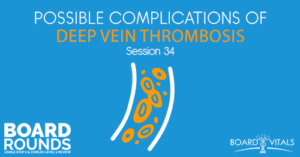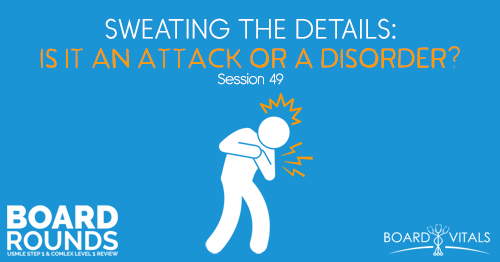Apple Podcasts | Google Podcasts

Session 34
A patient with a deep vein thrombosis (DVT) has not been using his heparin, and now he’s back with LLE weakness. What are his heart sounds, cranial MRI, and history revealing? As always, we’re joined by Dr. Mike Natter from BoardVitals. Follow him and his amazing artwork on Instagram @mike.natter.
Listen to this podcast episode with the player above, or keep reading for the highlights and takeaway points.
[01:30] Question of the Week
A 45-year-old male is presenting for evaluation of weakness and decreased sensation in his left lower extremity. His symptoms began eight hours ago. Five days earlier, he was diagnosed with a deep vein thrombosis (DVT). He was discharged home on a low-molecular-weight heparin.
However, he has been noncompliant with his treatment. His vital signs are as follows: He has a temperature of 98.4 degrees Fahrenheit. His pulse is 85 per minute. It’s regular. He has a blood pressure of 135/85. His exam reveals fixed splitting of S2 on cardiac auscultation.
His strength testing is only 2 out of 5 in his left lower extremity and has a diminished fine touch and proprioceptive sensation in his left lateral leg, foot, and ankle.
Laboratory studies are within normal limits including his platelets. His EKG showed normal sinus rhythm. Cranial MRI reveals a probable ischemic stroke and the distribution of a right anterior cerebral artery. EKG shows a dilation of the right atrium and ventricle.
Which of the following most likely caused his presentation?
(A) Thrombotic occlusion
(B) Paradoxical embolism
(C) Factor V Leiden mutation
(D) Heparin-induced thrombocytopenia (HIT)
(E) Septic embolus
[03:22] Thought Process Behind the Correct Cancer
There was nothing mentioned related to answer choice C so we throw it right off the bat. Answer choice E would usually be characterized by somebody being sick but he doesn’t appear sick. So E is crossed out as well.
In heparin-induced thrombocytopenia, platelets would be affected by that. Your body creates antibodies to the heparin which then attacks the platelets. Cyto means the platelet cells and “penia” meaning low. And his platelets are normal. So D is out.
The correct answer here is B. Thrombotic occlusion is a misleading answer choice because of the word thrombosis.
DVT is a blood clot in one of the veins down in your legs. Always remember that next to DVT should always be PE. They always go together. PE stands for pulmonary embolism.
Anytime a patient comes in with a DVT, the worst fear is it’s going to break off and embolize. An embolus is basically just a thrombus that got loose and shot up.
If you traced that circulation in a DVT, it breaks off, embolizes, and shoots up into the veinous system. Then it enters into the right side of the heart.
If you have normal anatomy, that would get stuck to the lungs. From the right ventricle, it goes right into the lungs where small blood vessels are and gas exchanges take place. The clot is smacked right in there and you have all the signs of the PE, which this guy may have had at some point.
Classical PE symptoms would include a right heart strain, you can typically see things on EKG, hypoxia, and a little bit of hemoptysis.
This guy has an atrial septal defect (ASD). Anytime you have a defect in between chambers of the heart, you’re going to have disruption of blood flow. The blood is going to go into areas you wouldn’t expect it.
The venous blood is connected to the arterial blood before it gets to the lungs. That clot made its way to the other side of the heart bypassing the lungs. It goes up into the systemic circulation and shoots up into the carotids up into the cerebral hemisphere causing the stroke. It’s called paradoxical for that reason where you don’t expect it to be because it wouldn’t allow that in normal anatomy.
[07:54] Recognizing a Classic ASD
Typically, it’s called Patent Foramen Ovale (PFO). Patent means open instead of closed. Foramen ovale is the embryologic hole in between the two atria that you’d have as a kid. ASD is an atrial septal defect. Surprisingly, some percentage of the adult population will just have a little PFO.
[09:28] Understanding Factor V Leiden Mutation
Factor V Leiden mutation is a genetic mutation that essentially makes you pro-thrombotic so you’re more likely to create clots. Typically, there would be a lot of thrombotic events. It’s very feasible that the guy could have had a Factor V Leiden mutation. But it doesn’t fit as well given he has an ASD and a DVT.
If he just had a DVT, maybe he’s got Factor V Leiden mutation and that’s predisposing into clotting. That can be the case. But because the rest of the question is really steering us towards something else. And because we don’t have a family history, they would direct you in the stem to know that this is a genetic mutation.
[11:00] BoardVitals
If you’re looking for some more help with your board prep, check out BoardVitals and their amazing QBanks for both USMLE Step 1 and COMLEX Level 1. Use the promo code BOARDROUNDS to save 15% off.
Links:
BoardVitals (Use the promo code BOARDROUNDS to save 15% off.)
Follow Dr. Mike Natter and his amazing artwork on Instagram @mike.natter
SEARCH SITE
LISTEN FOR FREE











